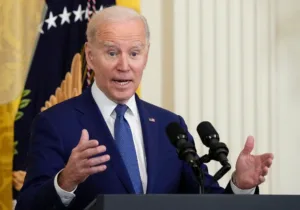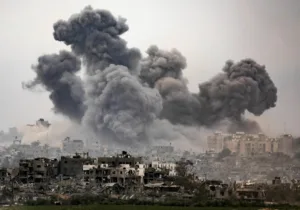“The definition of insanity,” Albert Einstein allegedly said, “is doing the same thing over and over and expecting a different result.” In the small country of Lebanon, the United States seems determined to embody Einstein’s view of insanity. For decades, Washington has embraced a counterproductive Lebanon policy long after its failures were apparent.
Across multiple administrations, the United States has operated under the fiction that Lebanon is a sovereign nation and that U.S. aid is somehow preserving American influence. To the contrary, Lebanon is controlled by Hezbollah, Iran’s foremost proxy. And Western security assistance has only propped up and enabled a state apparatus that, at best is unable to stand up to Hezbollah and at worst actively colludes with a terrorist group that murders Americans and seeks another genocide of Jewry.
And now—with serious conflict on the horizon in the Middle East—America is poised to reap its bitter harvest.
On Feb. 28, 2024 the Jerusalem Post cited reported that Tehran has given Hezbollah a “green light” to attack Israel once the Jewish state begins operations in the southern Gaza city of Rafah.
Hezbollah has been carrying out low-level attacks on Israel for months, dating back to when Hamas and other Iranian proxies invaded Israel on Oct. 7, 2023 and perpetrated the largest massacre of Jewish civilians since the Holocaust. These attacks not only cost lives but have also resulted in the mass displacement of civilians in the north of Israel.
The Israeli Defense Forces (IDF) reportedly found documents in Gaza that suggest that Hamas leaders believed that Hezbollah would launch a full-scale assault in conjunction with their attack.
Hezbollah likely hoped to draw Israel into a multi-front war. For years, Iran has been surrounding the Jewish state with its proxies. Mark Dubowitz and David Maxwell of the Foundation for the Defense of Democracies (FDD), a Washington D.C.-based think tank, have argued that this is part of Tehran’s “ring of fire” strategy in which Iran seeks to wrap itself, snake-like, around Israel and wear it down with a war of attrition on multiple fronts. Indeed, the Committee for Accuracy in Middle East Reporting and Analysis (CAMERA) has been warning of this possibility since February 2018.
Yet Hezbollah failed to fully mobilize its forces in time. And Israel has managed to make significant military progress in the south while avoiding a war on its northern border. But the sand seems to be shifting and a full-scale conflict with Lebanon looks increasingly likely. Such an outbreak would be the most devastating Middle Eastern war in decades.
Once called the “A Team” of terrorists by then-U.S. Deputy Secretary of State Richard Armitage, Hezbollah has greater capabilities than many nation-states. The group has more than 150,000 missiles, many precision-guided, and is far better armed and trained than Hamas, Palestinian Islamic Jihad, and other Iranian proxies. A fight with Hezbollah would be of a different scale and scope for the IDF. It would also devastate the civilians that the terrorist organization blatantly uses as human shields.
The Alma Research and Education Center, an Israeli-based NGO, has documented how ensconced Hezbollah is in civilian population centers in Lebanon, from towns in the country’s south to Beirut and beyond. Entire villages and communities sit atop weapons depots, launching pads, and Hezbollah bases. It would be impossible for the IDF to wage war and not have to hit these targets—a fact that Hezbollah knows all too well. The damage would be catastrophic—and not just for Lebanon. Indeed, the effects of the boiling conflict in the north are already being felt.
According to FDD, an estimated 100,000 Israelis from Israel’s north have already had to evacuate from near the Lebanese border. Displaced, many are living in temporary residences. Their plight has received little media attention. It is, in the long term, untenable. Something will have to give. Israeli Foreign Minister Israel Katz has warned that “time is running out to reach a diplomatic solution in southern Lebanon. Israel will act militarily to return the evacuated citizens in its northern border area if no diplomatic solution is reached.”
For its part, the United States has—on the surface at least—sought to prevent a greater conflict in the north. In late October, the U.S. dispatched two carrier groups to the area and Washington has sent envoys to try and prevent a broader Israel-Hezbollah war. But the dam is breaking.
In fact, what is unfolding is the cumulative failure of U.S. foreign policy in Lebanon. Indeed, far from preventing war, Washington has helped make it possible.
The United States has given copious security assistance to the Lebanese Armed Forces (LAF). In September 2022, the U.S. State Department called the aid “a key component of U.S. Lebanon policy” that “strengthens Lebanon’s sovereignty, secures its borders, counters internal threats and disrupts terrorist facilitation.” This, of course, is an absurdity. The precise opposite is true.
As Tony Badran, a Tablet magazine columnist and longtime analyst of Lebanese affairs observed, “Hezbollah, in fact, is Lebanon.” The terrorist group controls the Levantine state’s borders and ports of entry. Michel Aoun, the last president of Lebanon and commander-in-chief of its armed forces, has declared that Hezbollah’s growing arsenal “is not in contradiction with the state.” As the saying goes: who holds the gun holds the power. And in Lebanon, Hezbollah wields both.
In August 2021, a senior U.S. State Department official testified that the U.S. funded, trained and equipped the LAF to ensure that “they serve as an institutional counterweight to Hezbollah.” But as counterterrorist analyst David Kilcullen noted in a 2022 FDD monograph, an examination of the LAF’s performance since 2006 finds that the period of enhanced U.S. security assistance coincides with “a significant increase in Hezbollah’s influence.” Kilcullen argues that “crisis driven thinking” has dominated U.S. strategy toward Lebanon. It is also fair to lay the charge of naiveté. Washington may have bankrolled the LAF in the hopes that it will serve as a counterweight, but the nation’s armed forces have even colluded with the terror group.
As one Israeli official told the Times of Israel in 2018: “We see them working together, traveling in the same jeeps. Sometimes we see Hezbollah soldiers in LAF vests.” There are numerous other reports of Lebanon’s armed forces assisting Hezbollah. The LAF, it seems, is taking America for a ride.
Indeed, Lebanon has utterly and completely failed to enforce U.N. Security Council resolutions that remain the basis for U.S. and international support.
After the 2006 War between Israel and Hezbollah, the U.N. Security Council adopted Resolution 1701 which ordered that the area south of the Litani River be made “free of any armed personnel, assets, and weapons other than those of the Government of Lebanon and [and the UN Interim Force in Lebanon, or UNFIL]. But this manifestly has not happened.
Instead, as the ret. Israeli Gen. Assaf Orion noted in a January 2024 report for the Washington Institute for Near East Policy, Hezbollah has spent the intervening years building up its capabilities and flagrantly violating the resolution. In fact, Hezbollah’s very existence in Lebanon also violates UN Security Resolution 1559 which, like 1701, calls for Hezbollah to be disarmed.
Washington, however, has failed to recognize these realities. The U.S., France, and others have recently floated plans that would rely on the LAF and UNFIL to take a greater role in southern Lebanon. Yet more of the same is not the answer. The United States must acknowledge reality: its Lebanon policy is failing. And the dire consequences are coming into view.
As Israeli Defense Minister Yoav Gallant recently told U.S. envoy Amos Hochstein: “We are getting close to the point where the hourglass will turn over.”







 Sponsor a student for Christianity & National Security 2024
Sponsor a student for Christianity & National Security 2024